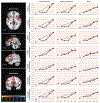Neural Substrates of Overgeneralized Conditioned Fear in PTSD
- PMID: 27794690
- PMCID: PMC7269602
- DOI: 10.1176/appi.ajp.2016.15121549
Neural Substrates of Overgeneralized Conditioned Fear in PTSD
Abstract
Objective: Heightened generalization of fear from an aversively reinforced conditioned stimulus (CS+, a conditioned danger cue) to resembling stimuli is widely accepted as a pathogenic marker of posttraumatic stress disorder (PTSD). Indeed, a distress response to benign stimuli that "resemble" aspects of the trauma is a central feature of the disorder. To date, the link between overgeneralization of conditioned fear and PTSD derives largely from clinical observations, with limited empirical work on the subject. This represents the first effort to examine behavioral and brain indices of generalized conditioned fear in PTSD using systematic methods developed in animals known as generalization gradients: the gradual decline in conditioned responding as the presented stimulus gradually differentiates from CS+.
Method: Gradients of conditioned fear generalization were assessed using functional MRI and behavioral measures in U.S. combat veterans who served in Iraq or Afghanistan and had PTSD (N=26), subthreshold PTSD (N=19), or no PTSD (referred to as trauma control subjects) (N=17). Presented stimuli included rings of graded size, with extreme sizes serving as CS+ (paired with shock) and as a nonreinforced conditioned stimulus (CS-, a conditioned safety cue), and with intermediate sizes forming a continuum of similarity between CS+ and CS-. Generalization gradients were assessed as response slopes from CS+, through intermediate ring sizes, to CS-, with less steep slopes indicative of stronger generalization.
Results: Relative to trauma control subjects, PTSD patients showed stronger conditioned generalization, as evidenced by less steep generalization gradients in both behavioral risk ratings and brain responses in the left and right anterior insula, left ventral hippocampus, dorsolateral and dorsomedial prefrontal cortex, and caudate nucleus. Severity of PTSD symptoms across the three study groups was positively correlated with levels of generalization at two such loci: the right anterior insula and left ventral hippocampus.
Conclusions: The results point to evidence of brain-based markers of overgeneralized fear conditioning related to PTSD. These findings provide further understanding of a central yet understudied symptom of trauma-related psychopathology.
Keywords: Biological Markers; Cognitive Neuroscience; Emotion; Posttraumatic Stress Disorder.
Conflict of interest statement
The authors report no financial relationships with commercial interests.
Figures




References
-
- Pavlov IP: Conditioned Reflexes. New York, Oxford University Press, 1927
-
- Cahill SP, Foa EB: Psychological theories of PTSD, in Handbook of PTSD: Science and Practice. Edited by Friedman MJ, Keane TM, Resick PA. New York, Guilford, 2007, pp 55–77
-
- Armony JL, Servan-Schreiber D, Romanski LM, et al.: Stimulus generalization of fear responses: effects of auditory cortex lesions in a computational model and in rats. Cereb Cortex 1997; 7:157–165 - PubMed
MeSH terms
Grants and funding
LinkOut - more resources
Full Text Sources
Other Literature Sources
Medical

